The ending of Raiders of the Lost Ark is easy to overlook. Once the movie’s done, you remember it being a big, visually thrilling finale, the hero victorious, the bad guys obliterated. Only it’s even darker than that. It’s barely a victory at all. Indy and Marion’s big accomplishment? They manage not to die. Everybody else is melted, electrocuted, or blown up, their corpses swallowed whole by the ark. And that’s it. Cut to the meeting where we learn the ark is in the care of “top men,” and, originally, cut to the warehouse. Only at the last minute did Spielberg shoot a quick scene with Indy and Marion together. It’s happy enough, but the movie’s no less ominous for its inclusion.
Indiana Jones and the Temple of Doom was largely hated upon its release for being too dark, depressing, and mean-spirited. Yet it ends with a hundred happy children running into the arms of their parents, Indy and Willie kissing, and Short Round’s elephant spewing water on them—hilarious! It’s as though the ending is an apology for all the monkey brains and child slavery that preceded it. It’s a terrible choice in a movie featuring nothing else. Every choice is terrible.
It’s also the only other enjoyable Indiana Jones movie.
Strange but true!
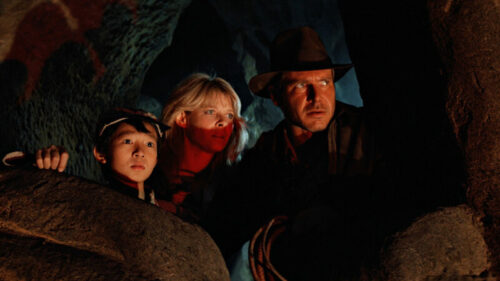
When I was a kid, it was a huge disappointment. It felt both like a retread and a reinvention: Indy was kind of a jerk, and his adventure was a cartoon. Reading about the audience reaction now, I see that much of the hatred at the time focused on the darkness of the movie, yet as a kid I loved horror movies, loved anything that scared or disturbed me, loved darkness. Something else was wrong with this movie. What was it?
Well. It was, mostly, everything. Still, one has to be impressed with what Spielberg and Lucas set out to do. They didn’t want to make another Raiders. They wanted to make a very different kind of movie. Which was not how one made sequels (then as now). The idea that any successful movie demanded a sequel was still somewhat new in ’84. Less than a decade. Long enough to know what to expect—the same movie again, but worse—but recent enough that any variation on that formula had the benefit of feeling fresh. So, not a sequel, but a prequel. Ooh! We all heard this back then and thought, gosh, how wild! What could it mean?
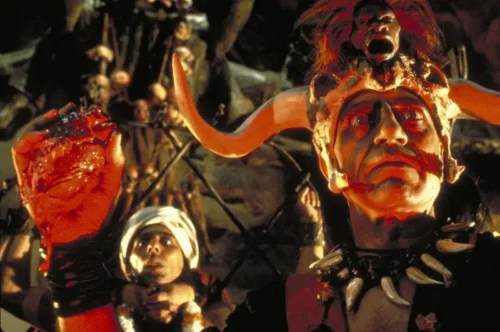
For the filmmakers, it meant they could show Indy not as the kind-hearted, artifact-respecting (well, sort of) professor we knew and loved from Raiders, but as the grave-robbing fortune-hunter he used to be, before this very adventure changed his outlook. Pretty cool idea, really.
But there was a big but, and the big but was this: Nowhere in Raiders is it established that Indy was ever this alleged scumbag. It wouldn’t have taken much. Marcus might have said, in that initial classroom conversation as Indy hands over the pieces he’s come home with:
“The museum, really? You know, Indy, I still can’t get over how much you’ve changed. Used to be you’d have sold these to the highest bidder. What really happened last year in India?”
“It’s a long story.”
“I’d love to hear it.”
“Okay. It started–”
“But not now, Indy. There are men here to see you.”
As no such convenient conversation takes place, Temple of Doom would have to do some heavy lifting in order to clue us in to what was happening: That Indy used to be a creep, and in this movie we’d see how he came to be the man we loved. Which even with heavy lifting would be a hard sell. Why would anyone want to see Indy as a heel?
The question is moot. Temple of Doom does exactly zero heavy lifting, to the point where, if you’re not really paying attention, Indy’s just Indy, with a few odd moments that do little but add to a growing suspicion that something’s off about this movie. The movie might have clarified his character in the first scene, but it’s much too busy with song and dance and chaos to bother. We meet Indy, and for some reason he’s trading away an artifact. Well, hmm, that’s—oh! And now he’s threatening to fork a singer, and—yikes! Everyone’s running and shooting! Next thing we know, he’s talking about fortune and glory, and after that? He’s pretty much just Indy. They don’t even bother playing up the idea that he might make off with the Sankara stones rather than return them to the village. There’s no big moment of decision. We’re all too busy riding the rollercoaster to care.
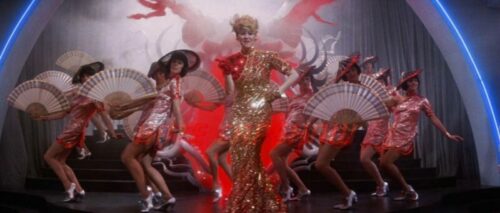
Which, to that point, funny story. Mrs. The Supreme Being always loved this movie, she watched it often as a kid. Last night, after watching it anew, I mentioned the above, how Indy’s transformation from grave-robber to saint is so bungled it hardly registers, and she interrupted to say, “Wait, what? It’s a prequel?”
No casual film viewer she, Mrs. The Supreme Being is neither inattentive nor likely to miss nuances of character. Yet, never having paid any real attention to which year in the ’30s this movie and Raiders are set, she just assumed Temple of Doom was a sequel. That’s how poorly Indy’s character is established. It’s a big problem that manages to be both invisible and pervasive.
And that’s just the character of Indy. What about the rest of the movie?
The next baffling choice is to turn it into a cartoon. Raiders deals in a bit of fantasy, and includes plenty of action that veers into the realm of the highly unlikely, but it’s set in the real world. It’s a movie born in the ’70s. Part of what makes it so appealing is that it’s both something we’re familiar with, in tone and appearance, and something new. It lays its wild action sequences and fantasy ending over a foundation of ’70s realism, all with the goal of evoking ’30s adventure serials.
That’s all jettisoned in the prequel. Nothing is remotely realistic. Temple of Doom is a Bugs Bunny cartoon inspired by Gunga Din with a literal roaller-coaster ride for a climax. Opening with a Shangai song and dance number is a fun idea, but then halfway through to launch us into a spaceless, Busby Berkeley fantasy realm? The unexpected setting is a great move. Announcing that nothing we’re about to see is real, less so.
The opening action sequence, despite our vague sense that something’s off about Indy, is still pretty great. It’s cartoony fun. And it ends with the best gag in the movie, “Lao Che” on the airplane door (to which they’re escorted by a British accented Dan Aykroyd). Falling from an airplane in a life raft was an idea left over from Raiders. They axed it because it was too unrealistic. Not anymore! It fits right in. It’s absurd. I always thought it looked awful, too, effects-wise. Still do. A lot of the effects look worse this time around. Not all. I love the swirling lava.
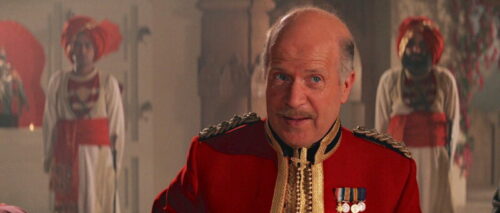
The next worst choice Spielberg et al make is when they must have said, “Marion is such a strong woman. Let’s do something different this time around,” and opted for a shrieking idiot in Willie. I’ve seen Kate Capshaw performances in which she’s a perfectly plausible human being, so I’m laying this performance at Spielberg’s feet. Maybe this is how he views his dream women? No matter one’s enjoyment of this movie, Willie is a real drag. Who, one wonders, was wishing to see Indy in a light sex-farce?
Up through that not-at-all-delightful, unconsummated bootie scene, Temple of Doom is a bit of a struggle. The “dinner” scene seems made for 10-year-olds and nobody else, let alone the insulting cultural absurdity of it. But once Indy feels up the statue and finds the tunnel, the movie starts to move. Of course there’s the matter of the last worst choice—child slavery—but at least in terms of action and movement and weird shit happening, Temple of Doom becomes a fun, dark cartoon. I even like Indy turning evil. A classic move in old serials. Sure, Spielberg bungles this, too, by having it speed by so quickly, but it’s a twist you don’t see coming. Probably another reason people hated the movie, of course. ” See! Indy drink human blood! Watch! Him sacrifice his latest girlfriend!” Not the best selling point.
I didn’t like Short Round when I was a kid. Raiders wasn’t a kids’ movie (I, the kid, then opined). But now? I love Short Round! And mostly, I like this movie. As long as I divorce it in my mind from Raiders, and think of it as a goofy dark cartoon version of the character, it’s mostly a fun ride.
That Spielberg and Lucas wanted to make their prequel different is impressive. It’s not something either one of them would ever do again. Audiences were mad, so the lesson learned was, “Audiences will hate anything new. Give them what they think they want.” The wrong lesson! Ever thus. Instead of understanding that the concept was cool, and the execution bungled, they imagined they’d made a great movie, but made it too dark and ugly and unusual and unexpected. No, the problem was the bungling. You can dare—you should dare!—but you can’t half-ass it.
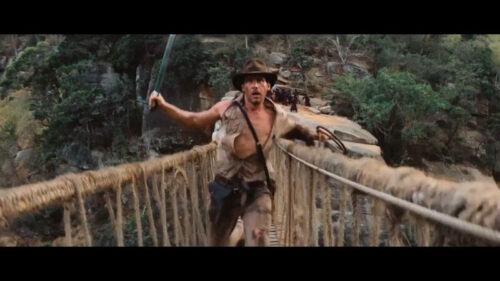

This was the first movie I went to see alone. I was eight years old. Somewhere around about the part where a man is shown his still beating heart after it is ripped out of his chest, I decided to go to the bathroom.
A concerned looking woman saw me stumbling into the foyer and asked me if I was ok- I said I’M FINE, then went into the restroom and looked at myself in the mirror.
Part of me is still in there, staring back through the glass in frozen, eternal horror.
I didn’t want to go back in, but I knew I had to.
INDY NEEDED ME.
Also I knew I couldn’t return to school on Monday without having seen the ending or I wouldn’t be able to talk about it all week.
I splashed water on my little kid face and looked again.
Where, just a moment before, there had been the reflection of a terrified child, now there was the reflection of a terrified child with a wet face.
But I felt like A MAN.
I went back in, sat down and secured my place in Valhalla.
And this is why neither of my kids are ever allowed to see a movie without me until they turn thirty.
Thank you. I love this story. For me, it was An American Werewolf in London at age 10 that really put the zap on my brain. As for the heart scene, I hope that you, as an 8 year old in ’84, didn’t also see Dreamscape and/or The Terminator. Both featured still-beating hearts yanked out of chests. It was a big year for hearts. And as for my one kid, he’s going to be well over 10 before I show him any werewolves.
I love Temple Of Doom, and the movie is better than Raiders Of The Lost Ark. I love Short Round and the action, and I appreciate the dark theme and I don’t mind screaming Willy. I hate the haters especially those that hate Short Round.